Toyota Corolla (2020 year). Owner's manual — part 33
518
8-2. Steps to take in an emergency
cleared. When the battery is
depleted, have the vehicle
inspected at your Toyota dealer.
●
Some systems may require initial-
ization. (P.556)
■
When removing the battery ter-
minals
When the battery terminals are
removed, the information stored in
the ECU is cleared. Before remov-
ing the battery terminals, contact
your Toyota dealer.
■
Charging the battery
The electricity stored in the battery
will discharge gradually even when
the vehicle is not in use, due to nat-
ural discharge and the draining
effects of certain electrical appli-
ances. If the vehicle is left for a long
time, the battery may discharge,
and the engine may be unable to
start. (The battery recharges auto-
matically during driving.)
■
When recharging or replacing
the battery (vehicles with a
smart key system)
●
In some cases, it may not be pos-
sible to unlock the doors using the
smart key system when the bat-
tery is discharged. Use the wire-
less remote control or the
mechanical key to lock or unlock
the doors.
●
The engine may not start on the
first attempt after the battery has
recharged but will start normally
after the second attempt. This is
not a malfunction.
●
The engine switch mode is memo-
rized by the vehicle. When the
battery is reconnected, the system
will return to the mode it was in
before the battery was dis-
charged. Before disconnecting the
battery, turn the engine switch off.
If you are unsure what mode the
engine switch was in before the
battery discharged, be especially
careful when reconnecting the
battery.
■
When replacing the battery
●
Use a battery that conforms to
European regulations.
●
Use a battery with the same case
size as the previous battery and
an equivalent 20 hour rate capac-
ity (20HR) or greater.
• If the sizes differ, the battery can-
not be properly secured.
• If the 20 hour rate capacity is low,
even if the time period where the
vehicle is not used is a short time,
the battery may discharge and the
engine may not be able to start.
●
For details, consult your Toyota
dealer.
WARNING
■
When removing the battery
terminals
Always remove the negative (-)
terminal first. If the positive (+) ter-
minal contacts any metal in the
surrounding area when the posi-
tive (+) terminal is removed, a
spark may occur, leading to a fire
in addition to electrical shocks
and death or serious injury.
■
Avoiding battery fires or
explosions
Observe the following precautions
to prevent accidentally igniting the
flammable gas that may be emit-
ted from the battery:
●
Make sure each jumper cable is
connected to the correct termi-
nal and that it is not unintention-
ally in contact with any other
than the intended terminal.
●
Do not allow the other end of
the jumper cable connected to
the “+” terminal to come into
contact with any other parts or
metal surfaces in the area, such
as brackets or unpainted metal.
-------------------------------------------------------------------------------------------------------------------------------------------------------------
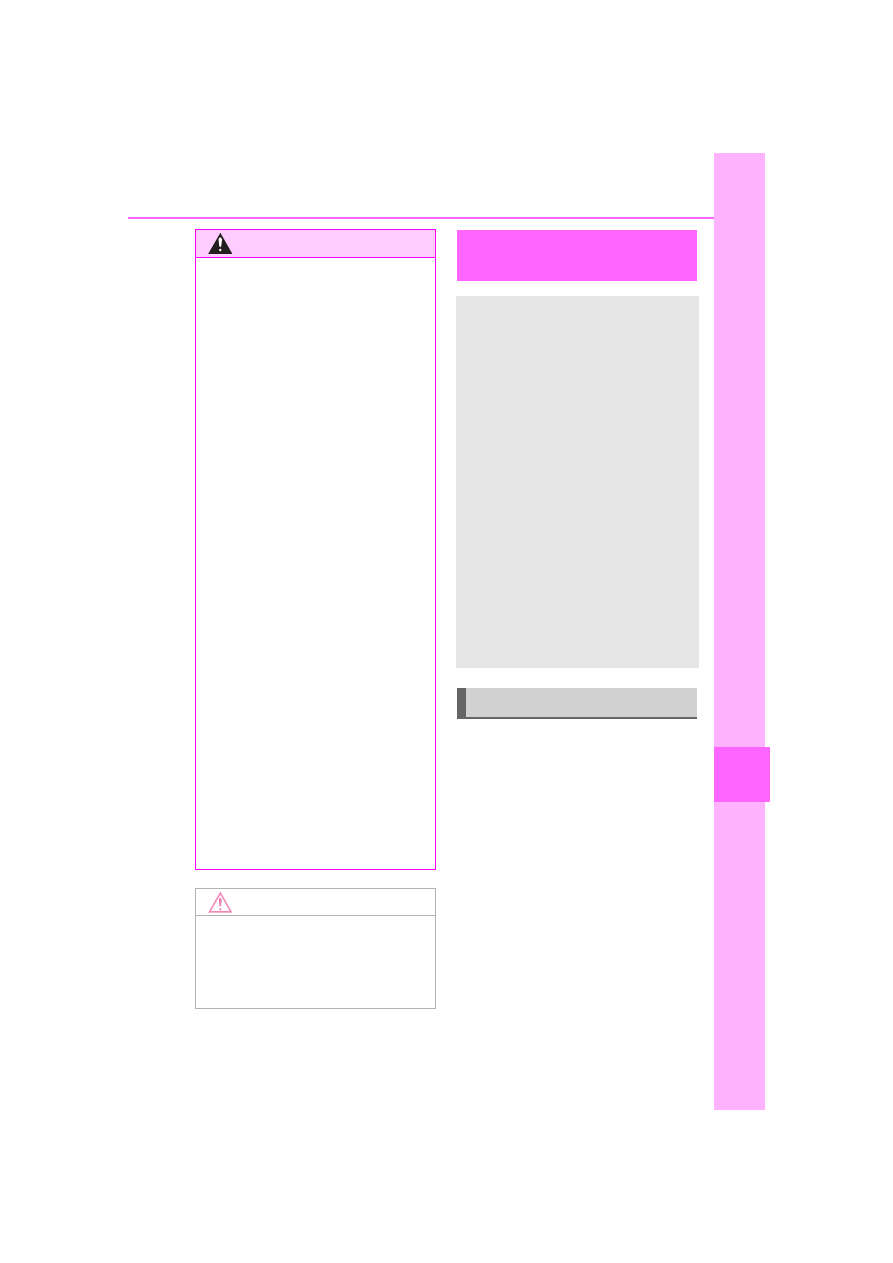
519
8-2. Steps to take in an emergency
8
Whe
n tr
ouble
ar
ises
1
Stop the vehicle in a safe
place and turn off the air con-
ditioning system, and then
stop the engine.
2
If you see steam: Carefully lift
the hood after the steam sub-
sides.
If you do not see steam:
Carefully lift the hood.
3
After the engine has cooled
down sufficiently, inspect the
WARNING
●
Do not allow the + and - clamps
of the jumper cables to come
into contact with each other.
●
Do not smoke, use matches,
cigarette lighters or allow open
flame near the battery.
■
Battery precautions
The battery contains poisonous
and corrosive acidic electrolyte,
while related parts contain lead
and lead compounds. Observe
the following precautions when
handling the battery:
●
When working with the battery,
always wear safety glasses and
take care not to allow any bat-
tery fluids (acid) to come into
contact with skin, clothing or the
vehicle body.
●
Do not lean over the battery.
●
In the event that battery fluid
comes into contact with the skin
or eyes, immediately wash the
affected area with water and
seek medical attention. Place a
wet sponge or cloth over the
affected area until medical
attention can be received.
●
Always wash your hands after
handling the battery support,
terminals, and other bat-
tery-related parts.
●
Do not allow children near the
battery.
NOTICE
■
When handling jumper cables
When connecting the jumper
cables, ensure that they do not
become entangled in the cooling
fan or engine drive belt.
If your vehicle over-
heats
The following may indicate
that your vehicle is over-
heating.
The engine coolant tem-
perature gauge (P.77, 81)
is in the red zone or a loss
of engine power is experi-
enced. (For example, the
vehicle speed does not
increase.)
“Engine Coolant Temp High
Stop in a Safe Place See
Owner’s Manual” is shown
on the multi-information dis-
play.
Steam comes out from
under the hood.
Correction procedures
-------------------------------------------------------------------------------------------------------------------------------------------------------------
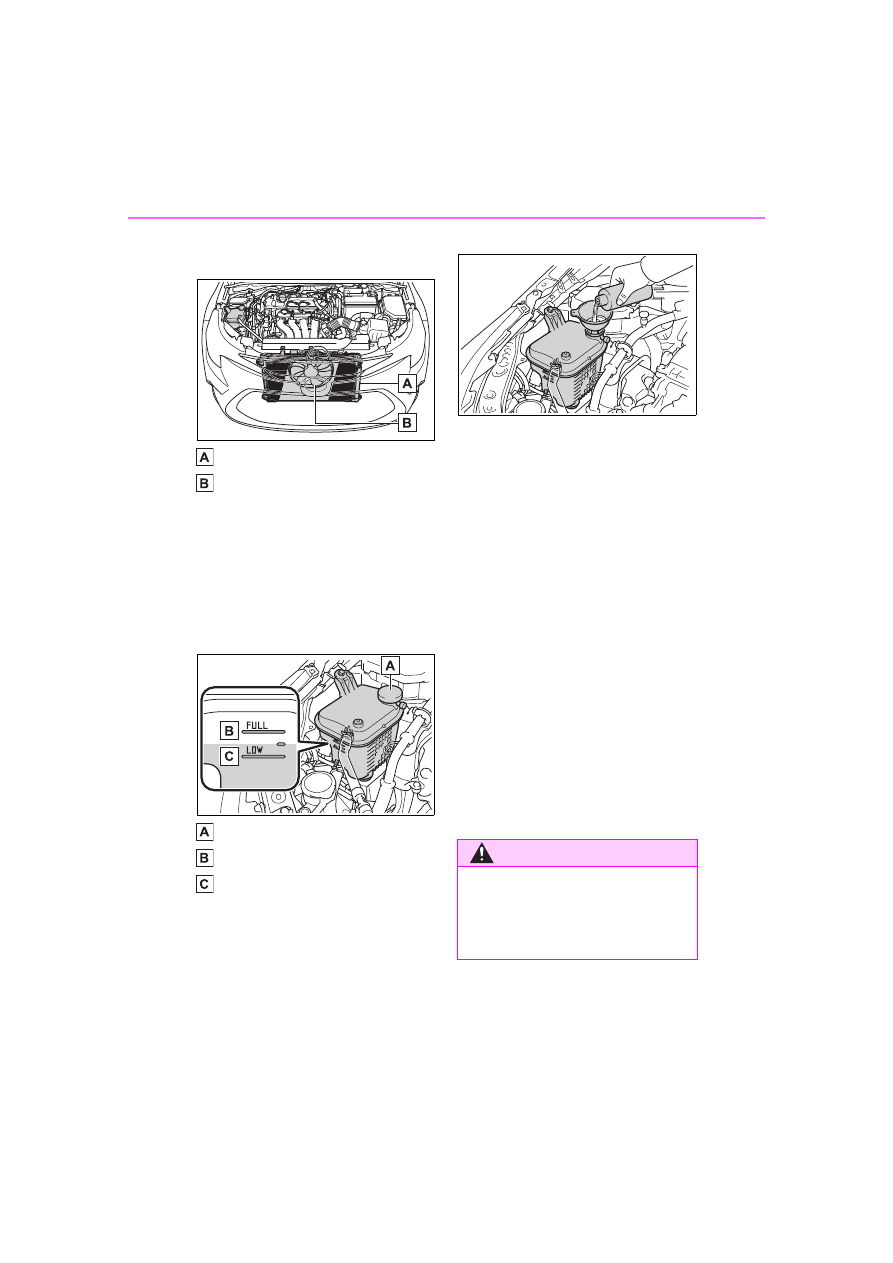
520
8-2. Steps to take in an emergency
hoses and radiator core (radi-
ator) for any leaks.
Radiator
Cooling fan
If a large amount of coolant leaks,
immediately contact your Toyota
dealer.
4
The coolant level is satisfac-
tory if it is between the
“FULL” and “LOW” lines on
the reservoir.
Reservoir
“FULL” line
“LOW” line
5
Add engine coolant if neces-
sary.
Water can be used in an emer-
gency if engine coolant is unavail-
able.
6
Start the engine and turn the
air conditioning system on to
check that the radiator cool-
ing fan operates and to check
for coolant leaks from the
radiator or hoses.
The fan operates when the air con-
ditioning system is turned on imme-
diately after a cold start. Confirm
that the fan is operating by check-
ing the fan sound and air flow. If it is
difficult to check these, turn the air
conditioning system on and off
repeatedly. (The fan may not oper-
ate in freezing temperatures.)
7
If the fan is not operating:
Stop the engine immediately
and contact your Toyota
dealer.
If the fan is operating: Have
the vehicle inspected at the
nearest Toyota dealer.
WARNING
■
When inspecting under the
hood of your vehicle
Observe the following precau-
tions. Failure to do so may result
in serious injury such as burns.
-------------------------------------------------------------------------------------------------------------------------------------------------------------
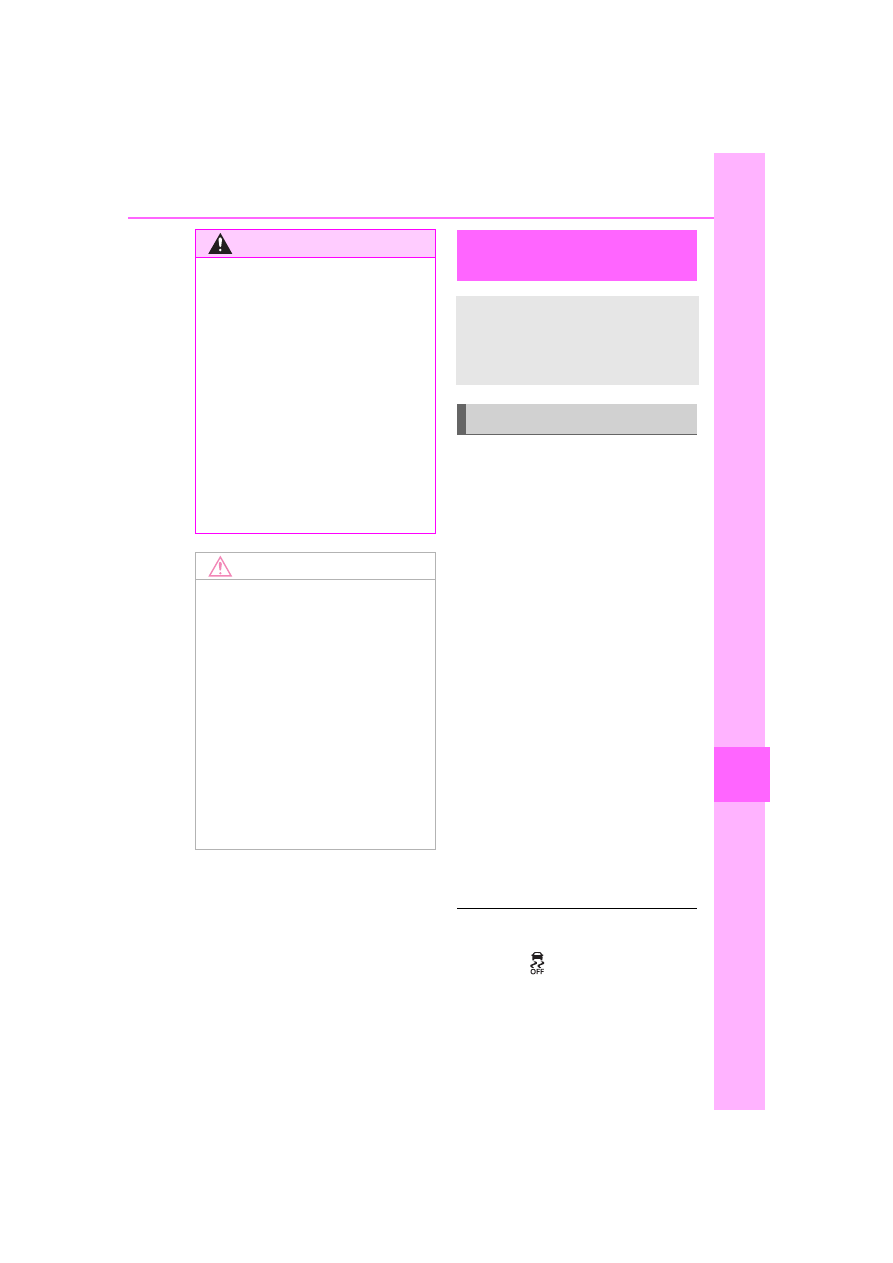
521
8-2. Steps to take in an emergency
8
Whe
n tr
ouble
ar
ises
1
Stop the engine. Set the
parking brake and shift the
shift lever to P (continuously
variable transmission) or N
(manual transmission).
2
Remove the mud, snow or
sand from around the front
wheels.
3
Place wood, stones or some
other material under the front
wheels to help provide trac-
tion.
4
Restart the engine.
5
Shift the shift lever to D or R
(continuously variable trans-
mission) or 1 or R (manual
transmission) and release
the parking brake. Then,
while exercising caution,
depress the accelerator
pedal.
■
When it is difficult to free the
vehicle
Press the
switch to turn off
TRAC.
WARNING
●
If steam is seen coming from
under the hood, do not open the
hood until the steam has sub-
sided. The engine compart-
ment may be very hot.
●
Keep hands and clothing (espe-
cially a tie, a scarf or a muffler)
away from the fan and belts.
Failure to do so may cause the
hands or clothing to be caught,
resulting in serious injury.
●
Do not loosen the coolant reser-
voir cap while the engine and
radiator are hot.
High temperature steam or
coolant could spray out.
NOTICE
■
When adding engine coolant
Add coolant slowly after the
engine has cooled down suffi-
ciently. Adding cool coolant to a
hot engine too quickly can cause
damage to the engine.
■
To prevent damage to the
cooling system
Observe the following precau-
tions:
●
Avoid contaminating the coolant
with foreign matter (such as
sand or dust etc.).
●
Do not use any coolant additive.
If the vehicle becomes
stuck
Carry out the following pro-
cedures if the tires spin or
the vehicle becomes stuck
in mud, dirt or snow:
Recovering procedure
-------------------------------------------------------------------------------------------------------------------------------------------------------------
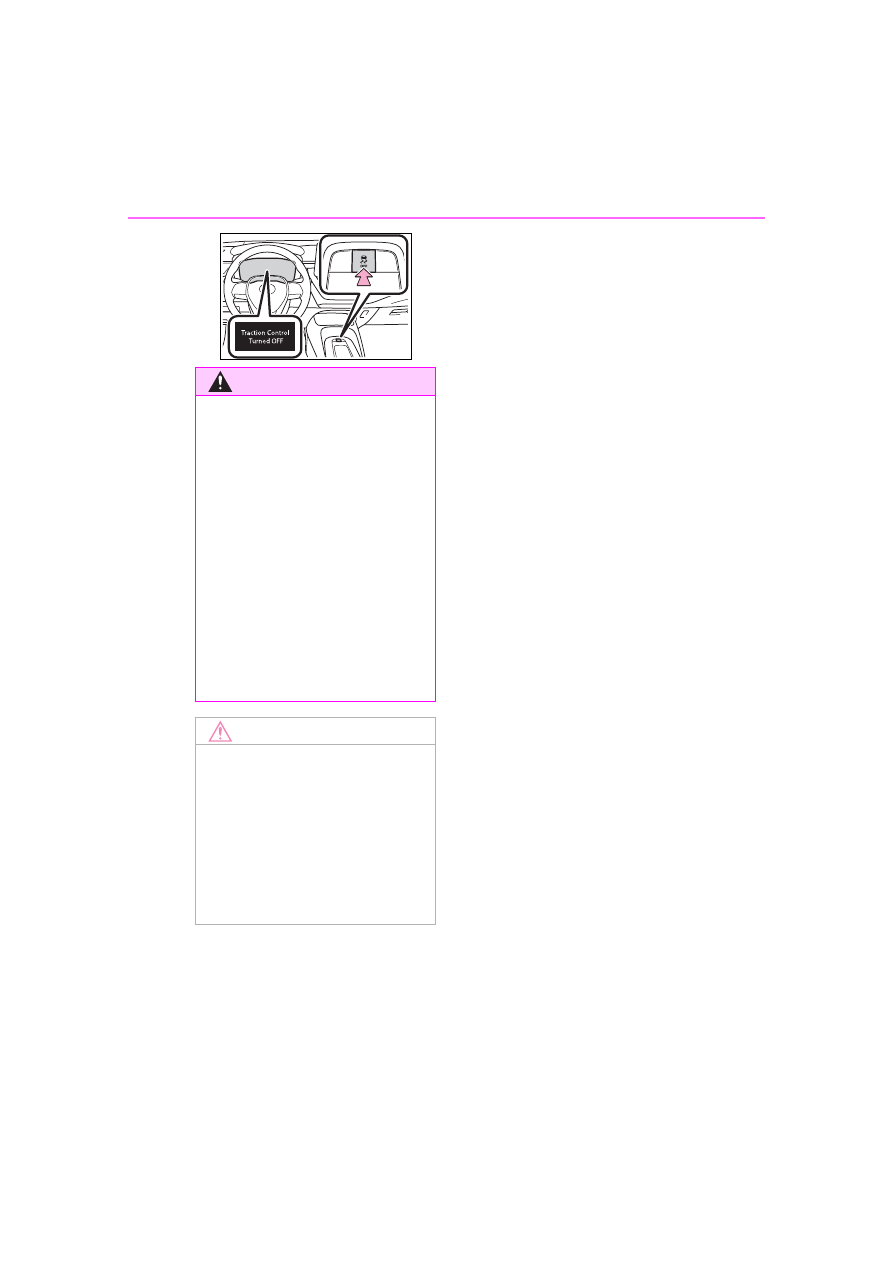
522
8-2. Steps to take in an emergency
WARNING
■
When attempting to free a
stuck vehicle
If you choose to push the vehicle
back and forth to free it, make
sure the surrounding area is clear
to avoid striking other vehicles,
objects or people. The vehicle
may also lunge forward or lunge
back suddenly as it becomes free.
Use extreme caution.
■
When shifting the shift lever
Be careful not to shift the shift
lever with the accelerator pedal
depressed.
This may lead to unexpected
rapid acceleration of the vehicle
that may cause an accident
resulting in death or serious injury.
NOTICE
■
To avoid damaging the trans-
mission and other compo-
nents
●
Avoid spinning the front wheels
and depressing the accelerator
pedal more than necessary.
●
If the vehicle remains stuck
even after these procedures are
performed, the vehicle may
require towing to be freed.
-------------------------------------------------------------------------------------------------------------------------------------------------------------
523
9
9
Vehicle
specificatio
ns
Vehicle specifications
.
9-1. Specifications
Maintenance data (fuel, oil
level, etc.). . . . ..
Fuel information . . ..
Tire information . . ...
9-2. Customization
Customizable features
. . . . . . . . ..
9-3. Initialization
Items to initialize . . .
-------------------------------------------------------------------------------------------------------------------------------------------------------------
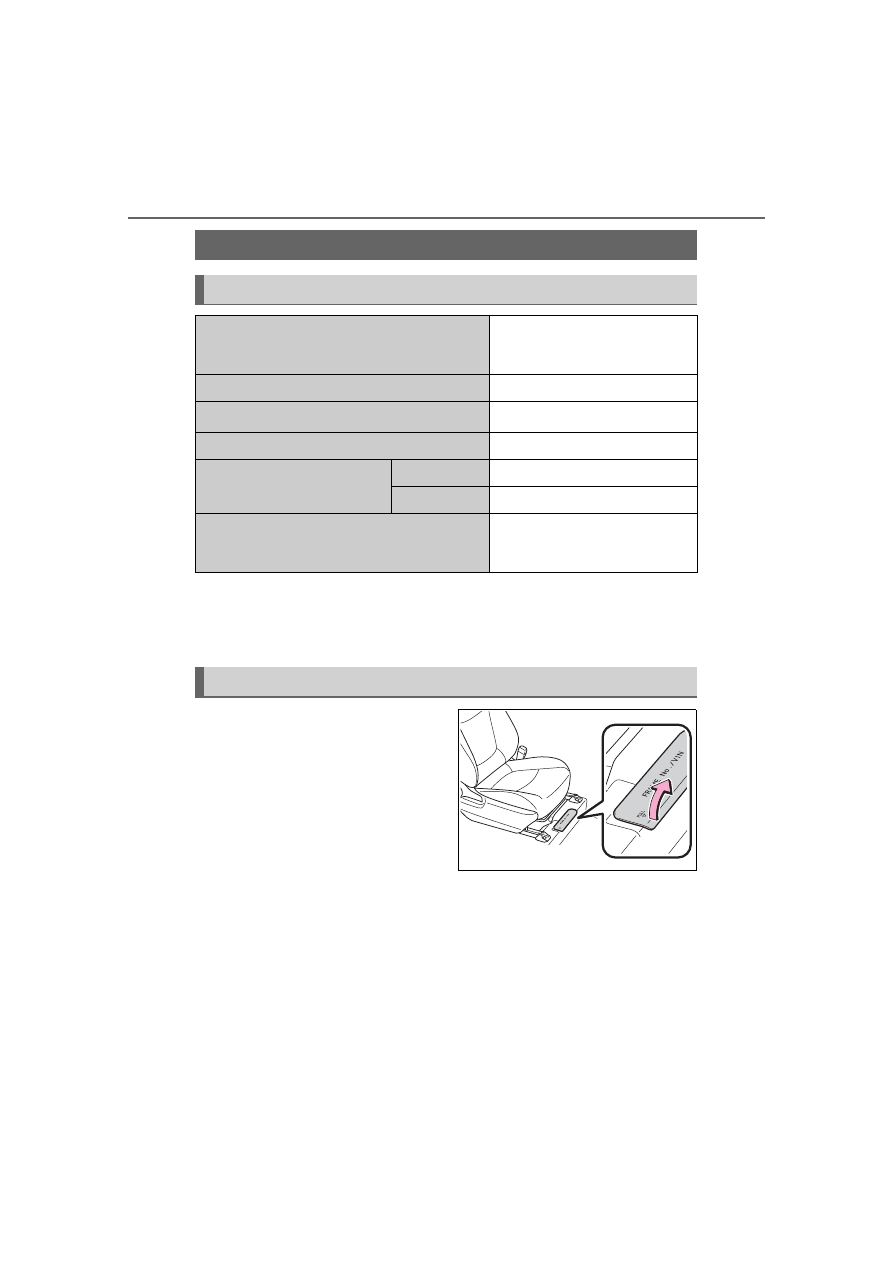
524
9-1. Specifications
9-1.Specifications
*1
:Unladen vehicles
*2
:1.8 L 4-cylinder (2ZR-FAE) engine
*3
:2.0 L 4-cylinder (M20A-FKS) engine
■
Vehicle identification num-
ber
The vehicle identification num-
ber (VIN) is the legal identifier
for your vehicle. This is the pri-
mary identification number for
your Toyota. It is used in regis-
tering the ownership of your
vehicle.
This number is stamped under
the right-hand front seat.
This number is also stamped on
the top left of the instrument
panel.
Maintenance data (fuel, oil level, etc.)
Dimensions and weight
Overall length
182.3 in. (4630 mm)
*2
182.5 in. (4635 mm)
*3
Overall width
70.1 in. (1780 mm)
Overall height
*1
56.5 in. (1435 mm)
Wheelbase
106.3 in. (2700 mm)
Tread
Front
60.3 in. (1531 mm)
Rear
60.8 in. (1544 mm)
Vehicle capacity weight
(Occupants + luggage)
825 lb. (375 kg)
*2
860 lb. (390 kg)
*3
Vehicle identification
-------------------------------------------------------------------------------------------------------------------------------------------------------------
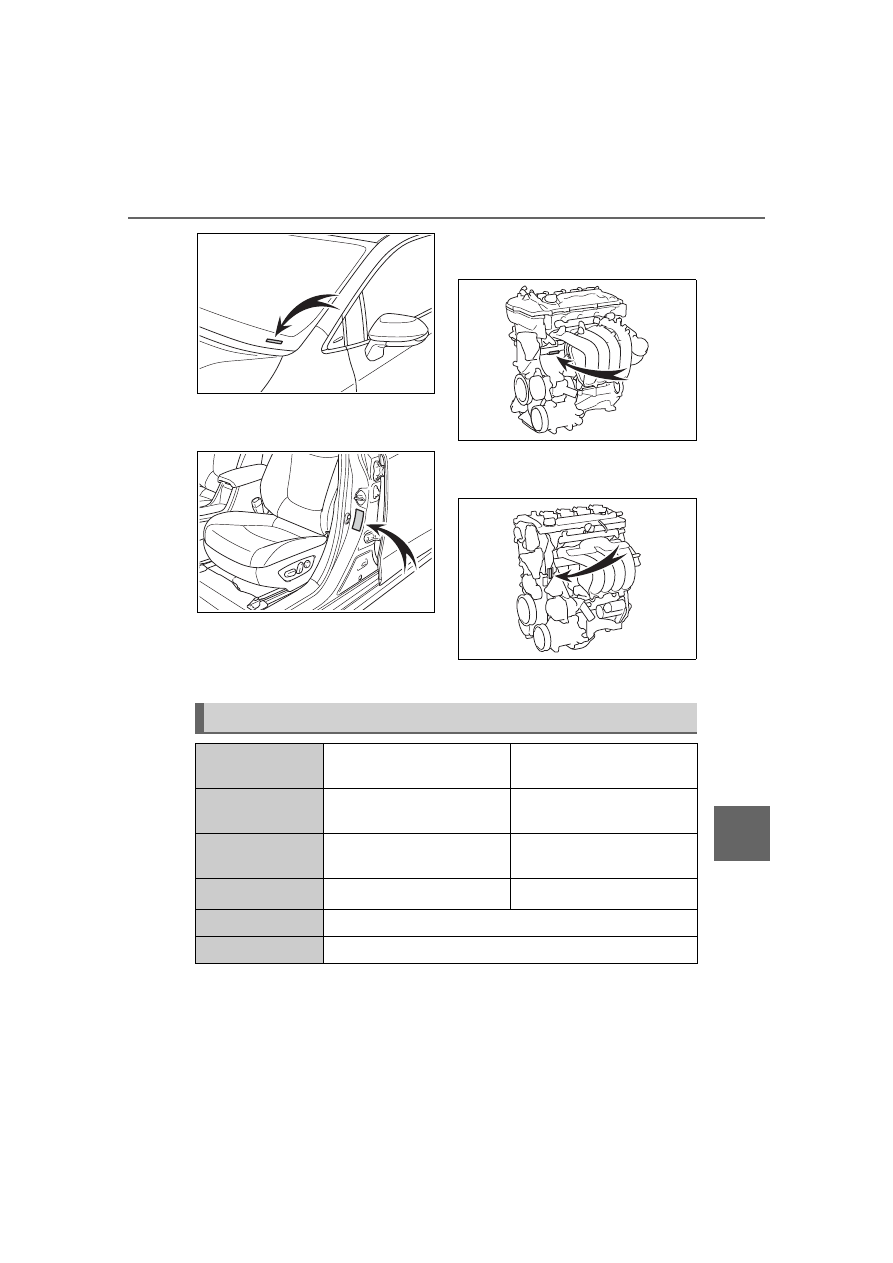
525
9-1. Specifications
9
Vehicle
specificatio
ns
This number is also on the Certi-
fication Label.
■
Engine number
The engine number is stamped
on the engine block as shown.
1.8 L 4-cylinder (2ZR-FAE)
engine
2.0 L 4-cylinder (M20A-FKS)
engine
Engine
Model
1.8 L 4-cylinder (2ZR-FAE)
2.0 L 4-cylinder
(M20A-FKS)
Type
4-cylinder in line, 4-cycle,
gasoline
4-cylinder in line, 4-cycle,
gasoline
Bore and stroke
3.17 3.48 in. (80.5 88.3
mm)
3.17 3.84 in. (80.5 97.6
mm)
Displacement
109.7 cu. in. (1798 cm
3
)
121.3 cu. in. (1987 cm
3
)
Valve clearance
Automatic adjustment
Drive belt tension Automatic adjustment
-------------------------------------------------------------------------------------------------------------------------------------------------------------
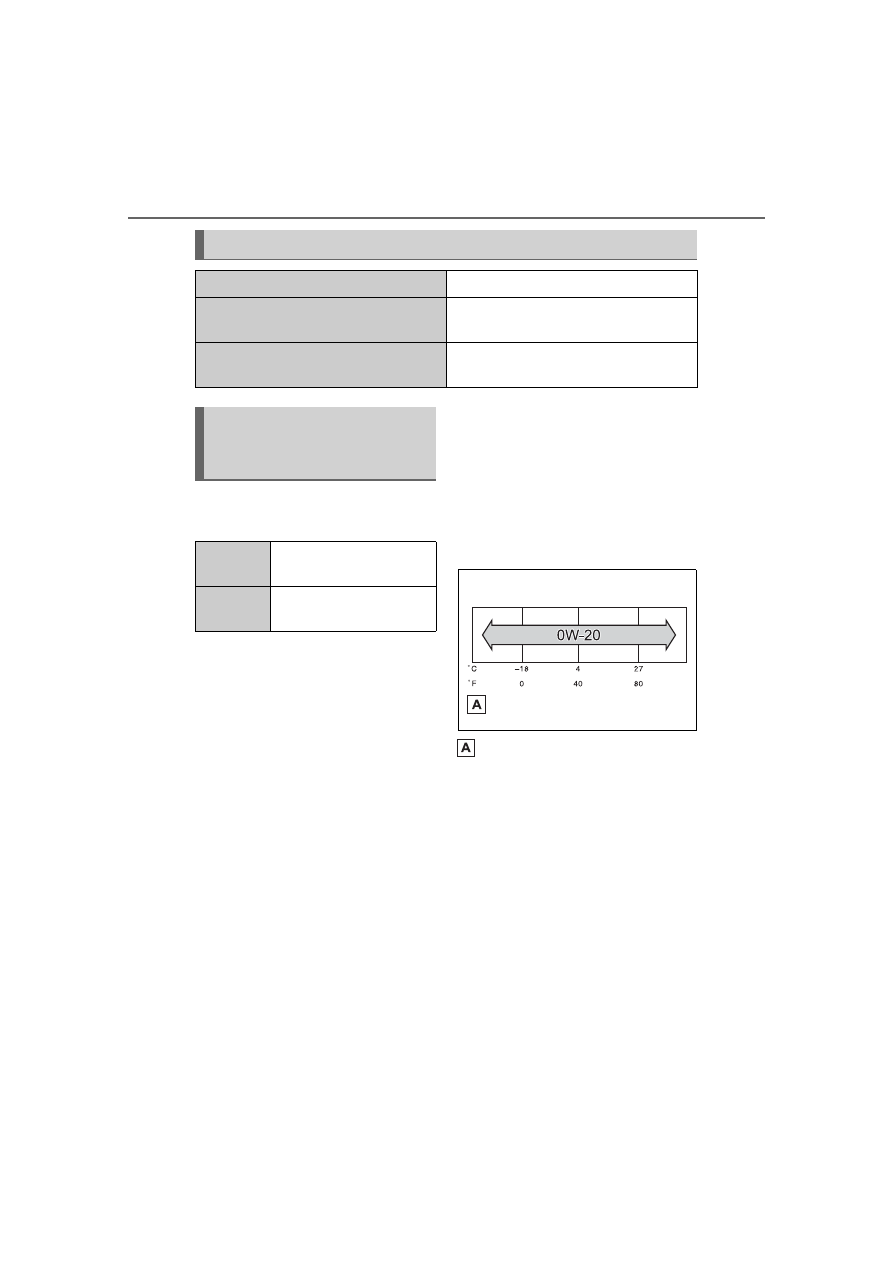
526
9-1. Specifications
■
Oil capacity (Drain and refill
[Reference
*
])
*
: The engine oil capacity is a refer-
ence quantity to be used when
changing the engine oil. Warm up
and turn off the engine, wait more
than 5 minutes, and check the oil
level on the dipstick.
■
Engine oil selection
“Toyota Genuine Motor Oil” is
used in your Toyota vehicle. Use
Toyota approved “Toyota Genu-
ine Motor Oil” or equivalent to
satisfy the following grade and
viscosity.
Oil grade: ILSAC GF-5 multi-
grade engine oil
Recommended viscosity: SAE
0W-20
SAE 0W-20 is the best choice
for good fuel economy and good
starting in cold weather.
If SAE 0W-20 is not available,
SAE 5W-20 oil may be used.
However, it must be replaced
with SAE 0W-20 at the next oil
change.
Recommended viscosity (SAE):
Outside temperature
Oil viscosity (0W-20 is explained
here as an example):
• The 0W in 0W-20 indicates
the characteristic of the oil
which allows cold startability.
Oils with a lower value before
the W allow for easier starting
of the engine in cold weather.
• The 20 in 0W-20 indicates the
viscosity characteristic of the
oil when the oil is at high tem-
perature. An oil with a higher
viscosity (one with a higher
Fuel
Fuel type
Unleaded gasoline only
Octane Rating
87 (Research Octane Number 91) or
higher
Fuel tank capacity
(Reference)
13.2 gal. (50.0 L, 11.0 Imp. gal.)
Lubrication system (1.8 L
4-cylinder [2ZR-FAE]
engine)
With filter
4.4 qt. (4.2 L, 3.7 Imp.
qt.)
Without
filter
4.1 qt. (3.9 L, 3.4 Imp.
qt.)
-------------------------------------------------------------------------------------------------------------------------------------------------------------
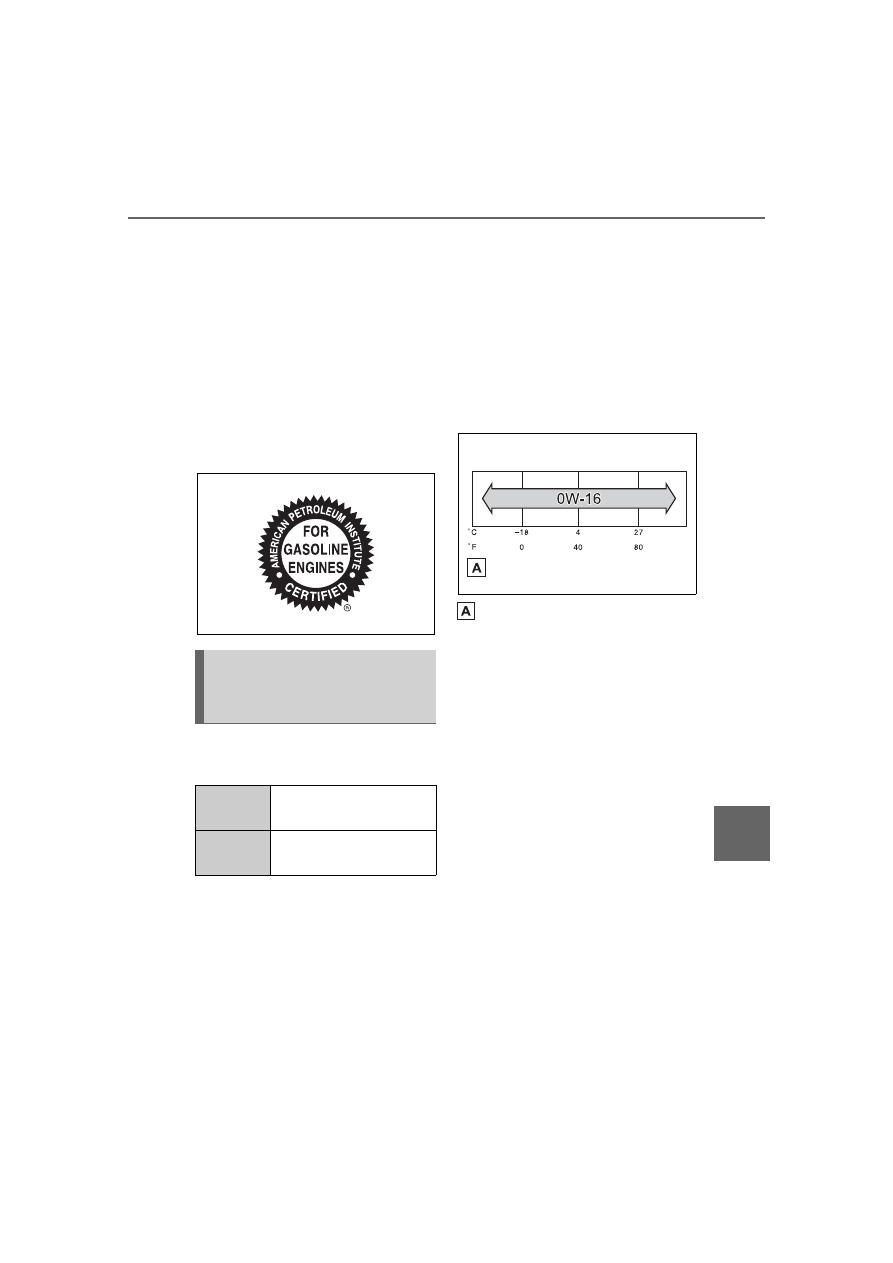
527
9-1. Specifications
9
Vehicle
specificatio
ns
value) may be better suited if
the vehicle is operated at high
speeds, or under extreme
load conditions.
How to read oil container label:
The International Lubricant
Specification Advisory Commit-
tee (ILSAC) Certification Mark is
added to some oil containers to
help you select the oil you
should use.
■
Oil capacity (Drain and refill
[Reference
*
])
*
: The engine oil capacity is a refer-
ence quantity to be used when
changing the engine oil. Warm up
and turn off the engine, wait more
than 5 minutes, and check the oil
level on the dipstick.
■
Engine oil selection
“Toyota Genuine Motor Oil” is
used in your Toyota vehicle. Use
Toyota approved “Toyota Genu-
ine Motor Oil” or equivalent to
satisfy the following grade and
viscosity.
Oil grade: API SN/RC multi-
grade engine oil
Recommended viscosity: SAE
0W-16
Outside temperature
SAE 0W-16 is the best choice
for good fuel economy and good
starting in cold weather.
If SAE 0W-16 is not available,
SAE 0W-20 oil may be used.
However, it must be replaced
with SAE 0W-16 at the next oil
change.
Oil viscosity (0W-16 is explained
here as an example):
• The 0W in 0W-16 indicates
the characteristic of the oil
which allows cold startability.
Oils with a lower value before
the W allow for easier starting
of the engine in cold weather.
• The 16 in 0W-16 indicates the
viscosity characteristic of the
oil when the oil is at high tem-
perature. An oil with a higher
Lubrication system (2.0 L
4-cylinder [M20A-FKS]
engine)
With filter
4.9 qt. (4.6 L, 4.0 Imp.
qt.)
Without
filter
4.5 qt. (4.3 L, 3.8 Imp.
qt.)
-------------------------------------------------------------------------------------------------------------------------------------------------------------

528
9-1. Specifications
viscosity (one with a higher
value) may be better suited if
the vehicle is operated at high
speeds, or under extreme
load conditions.
How to read oil container label:
API registered marks is added
to some oil containers to help
you select the oil you should
use.
Cooling system
Capacity (Reference)
1.8 L 4-cylinder (2ZR-FAE) engine
Continuously variable transmission:
6.1 qt. (5.8 L, 5.1 Imp. qt.)
Manual transmission:
5.9 qt. (5.6 L, 4.9 Imp. qt.)
2.0 L 4-cylinder (M20A-FKS) engine
Continuously variable transmission:
6.6 qt. (6.2 L, 5.5 Imp. qt.)
Manual transmission:
6.2 qt. (5.9 L, 5.2 Imp. qt.)
Coolant type
Use either of the following:
“Toyota Super Long Life Coolant”
Similar high-quality ethylene glycol-based
non-silicate, non-amine, non-nitrite, and
non-borate coolant with long-life hybrid organic
acid technology
Do not use plain water alone.
Ignition system (spark plug)
Make
1.8 L 4-cylinder (2ZR-FAE) engine
DENSO FC16HR-Q8
2.0 L 4-cylinder (M20A-FKS) engine
DENSO FC20HR-Q8
Gap
0.032 in. (0.8 mm)
-------------------------------------------------------------------------------------------------------------------------------------------------------------

529
9-1. Specifications
9
Vehicle
specificatio
ns
*
: The fluid capacity is a reference quantity.
If replacement is necessary, contact your Toyota dealer.
NOTICE
■
Iridium-tipped spark plugs
Use only iridium-tipped spark plugs. Do not adjust the spark plug gap.
Electrical system (battery)
Open voltage at 68°F (20°C):
12.3 V or higher
(Turn the engine switch off and turn on the
high beam headlights for 30 seconds.)
Charging rates
Quick charge
Slow charge
15 A max.
5 A max.
Continuously variable transmission
Fluid capacity
*
1.8 L 4-cylinder (2ZR-FAE) engine
7.9 qt. (7.5 L, 6.6 Imp. qt.)
2.0 L 4-cylinder (M20A-FKS) engine
9.0 qt. (8.5 L, 7.5 Imp. qt.)
Fluid type
Toyota Genuine CVT Fluid FE
NOTICE
■
Continuously variable transmission fluid type
Using continuously variable transmission fluid other than “Toyota Genuine
CVT Fluid FE” may cause deterioration in shift quality, locking up of trans-
mission accompanied by vibration and, ultimately, damage to the vehicle’s
transmission.
Manual transmission
Gear oil capacity (Reference)
1.8 L 4-cylinder (2ZR-FAE) engine
2.5 qt. (2.4 L, 2.1 Imp. qt.)
2.0 L 4-cylinder (M20A-FKS) engine
1.6 qt. (1.5 L, 1.3 Imp. qt.)
Gear oil type
“TOYOTA Genuine Manual Transmission
Gear Oil LV GL-4 75W” or equivalent
-------------------------------------------------------------------------------------------------------------------------------------------------------------
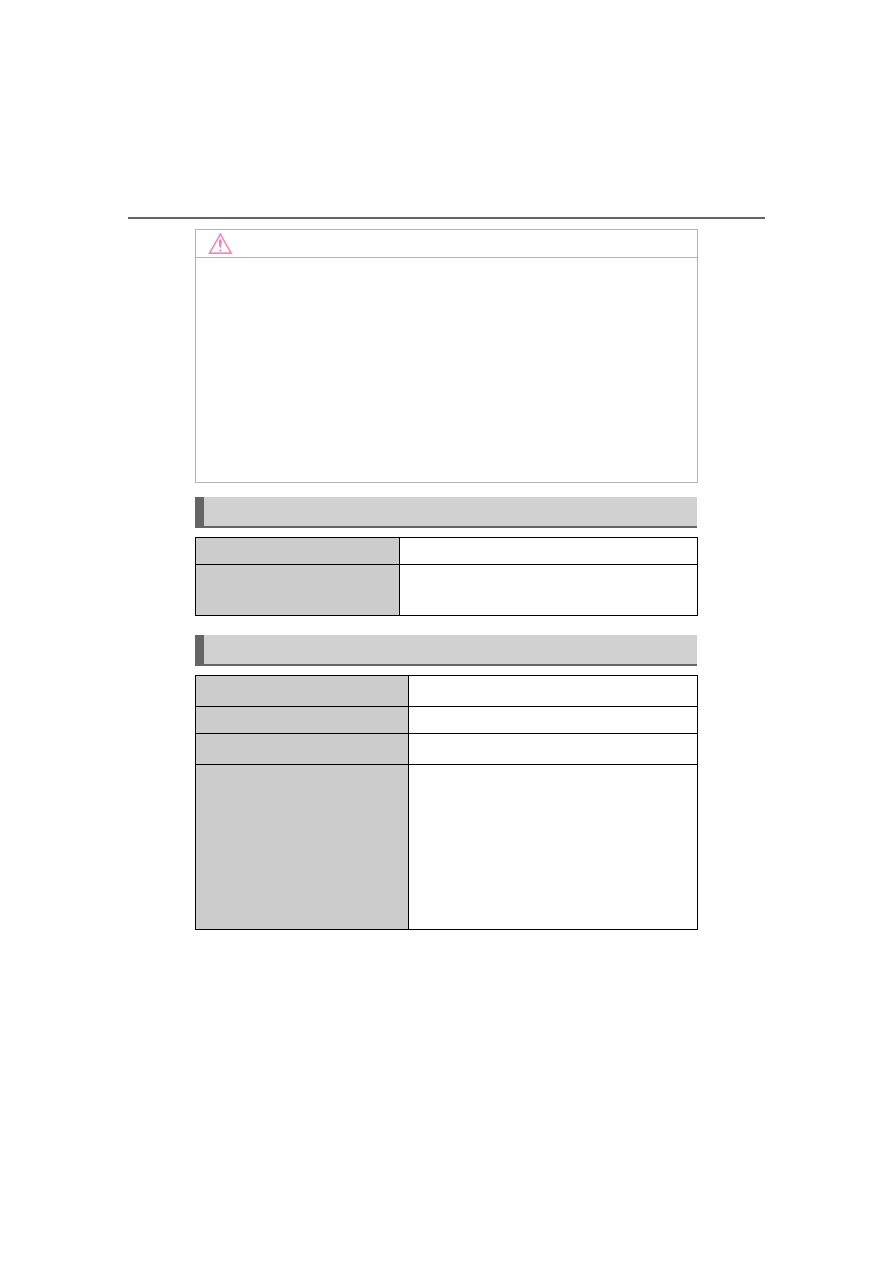
530
9-1. Specifications
NOTICE
■
Manual transmission gear oil type
●
Please be aware that depending on the particular characteristics of the
gear oil used or the operating conditions, idle sound, shift feeling and/or
fuel efficiency may be different or affected and, in the worst case, dam-
age to the vehicle’s transmission.
Toyota recommends to use “TOYOTA Genuine Manual Transmission
Gear Oil LV GL-4 75W” to achieve optimal performance.
●
Your Toyota vehicle is filled with “TOYOTA Genuine Manual Transmis-
sion Gear Oil LV GL-4 75W” at the factory.
Use Toyota approved “TOYOTA Genuine Manual Transmission Gear Oil
LV GL-4 75W” or an equivalent oil of matching quality that satisfies the
above specifications.
Please contact your Toyota dealer for further details.
Clutch
Pedal free play
0.1 0.6 in. (3 15 mm)
Fluid type
FMVSS No.116 DOT 3 or SAE J1703
FMVSS No.116 DOT 4 or SAE J1704
Brakes
Pedal clearance
*1
4.1 in. (105 mm) Min.
Pedal free play
0.04 0.24 in. (1 6 mm)
Parking brake lever travel
*2, 3
5 8 clicks
Brake pad wear limit
Front
0.06 in. (1.5 mm)
Rear
Vehicles without a electric parking brake:
0.06 in. (1.5 mm)
Vehicles with a electric parking brake:
0.08 in. (2.0 mm)
-------------------------------------------------------------------------------------------------------------------------------------------------------------

531
9-1. Specifications
9
Vehicle
specificatio
ns
*1
:Minimum pedal clearance when depressed with a force of 67.4 lbf (300
N, 30.6 kgf) while the engine is running.
*2
:If equipped
*3
:Parking brake lever travel when pulled up with a force of 45.0 lbf (200 N,
20.4 kgf)
*4
:Make sure to confirm that the brake system warning light (yellow) does
not illuminate. (If the brake system warning light illuminates, refer to
P.481.)
Type A
Parking brake indicator
*4
When pulling the parking brake switch for
1 to 2 seconds: comes on
When pushing the parking brake switch for
1 to 2 seconds: turns off
Fluid type
FMVSS No.116 DOT 3 or SAE J1703
FMVSS No.116 DOT 4 or SAE J1704
Steering
Free play
Less than 1.2 in. (30 mm)
Tires and wheels
Tire size
195/65R15 91S, T125/70D17 98M
Tire inflation pressure
(Recommended cold tire
inflation pressure)
Front
38 psi (260 kPa, 2.6 kgf/cm
2
or bar)
Rear
36 psi (250 kPa, 2.5 kgf/cm
2
or bar)
Spare
60 psi (420 kPa, 4.2 kgf/cm
2
or bar)
Wheel size
15 6 1/2J, 17 4T (compact spare)
Wheel nut torque
76 ft•lbf (103 N•m, 10.5 kgf•m)
-------------------------------------------------------------------------------------------------------------------------------------------------------------
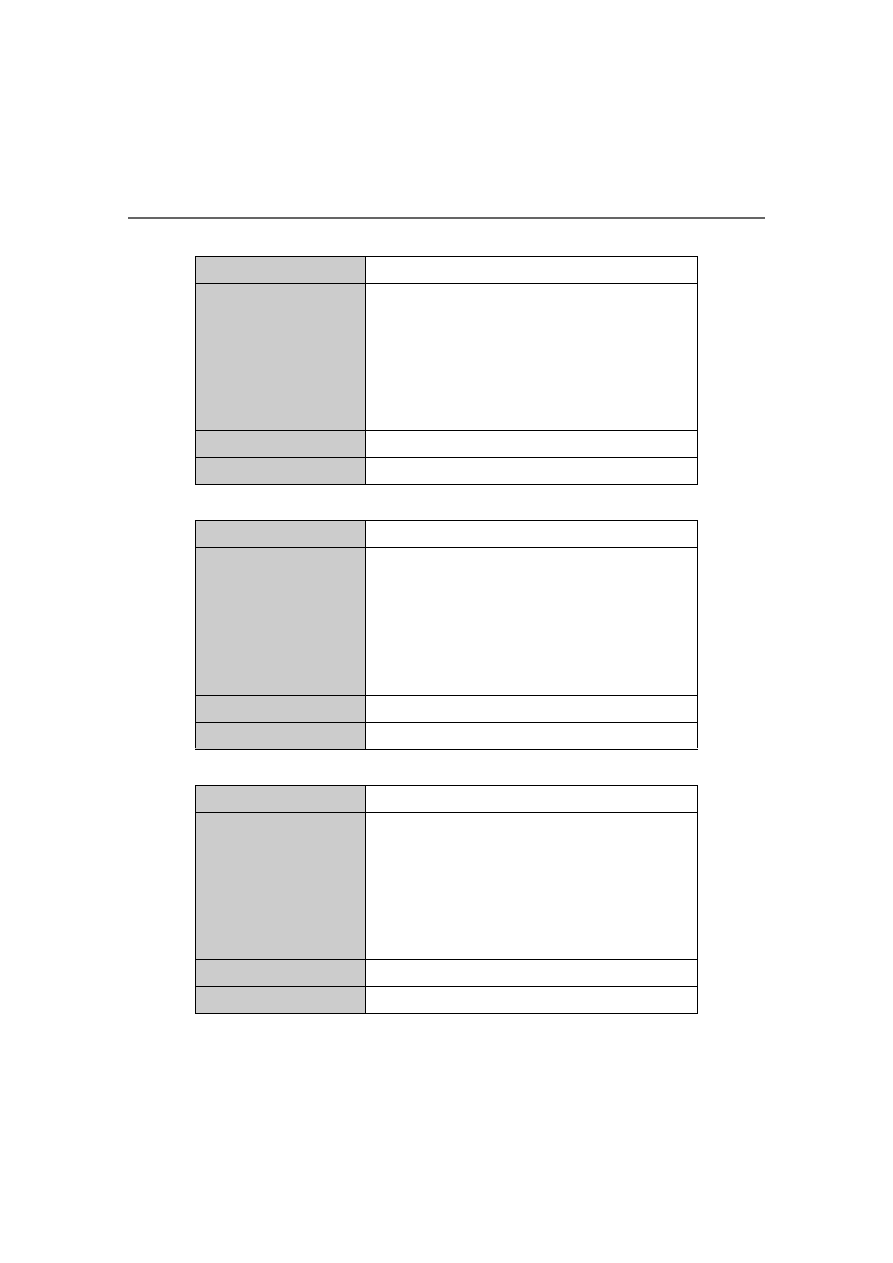
532
9-1. Specifications
Type B
Type C
Type D
Tire size
205/55R16 91H, T125/70D17 98M
Tire inflation pressure
(Recommended cold tire
inflation pressure)
Front
35 psi (240 kPa, 2.4 kgf/cm
2
or bar)
Rear
33 psi (230 kPa, 2.3 kgf/cm
2
or bar)
Spare
60 psi (420 kPa, 4.2 kgf/cm
2
or bar)
Wheel size
16 7J, 17 4T (compact spare)
Wheel nut torque
76 ft•lbf (103 N•m, 10.5 kgf•m)
Tire size
205/55R16 91V, T125/70D17 98M
Tire inflation pressure
(Recommended cold tire
inflation pressure)
Front
32 psi (220 kPa, 2.2 kgf/cm
2
or bar)
Rear
32 psi (220 kPa, 2.2 kgf/cm
2
or bar)
Spare
60 psi (420 kPa, 4.2 kgf/cm
2
or bar)
Wheel size
16 7J, 17 4T (compact spare)
Wheel nut torque
76 ft•lbf (103 N•m, 10.5 kgf•m)
Tire size
225/40R18 88V, T125/70D17 98M
Tire inflation pressure
(Recommended cold tire
inflation pressure)
Front
33 psi (230 kPa, 2.3 kgf/cm
2
or bar)
Rear
30 psi (210 kPa, 2.1 kgf/cm
2
or bar)
Spare
60 psi (420 kPa, 4.2 kgf/cm
2
or bar)
Wheel size
18 8J, 17 4T (compact spare)
Wheel nut torque
76 ft•lbf (103 N•m, 10.5 kgf•m)
-------------------------------------------------------------------------------------------------------------------------------------------------------------
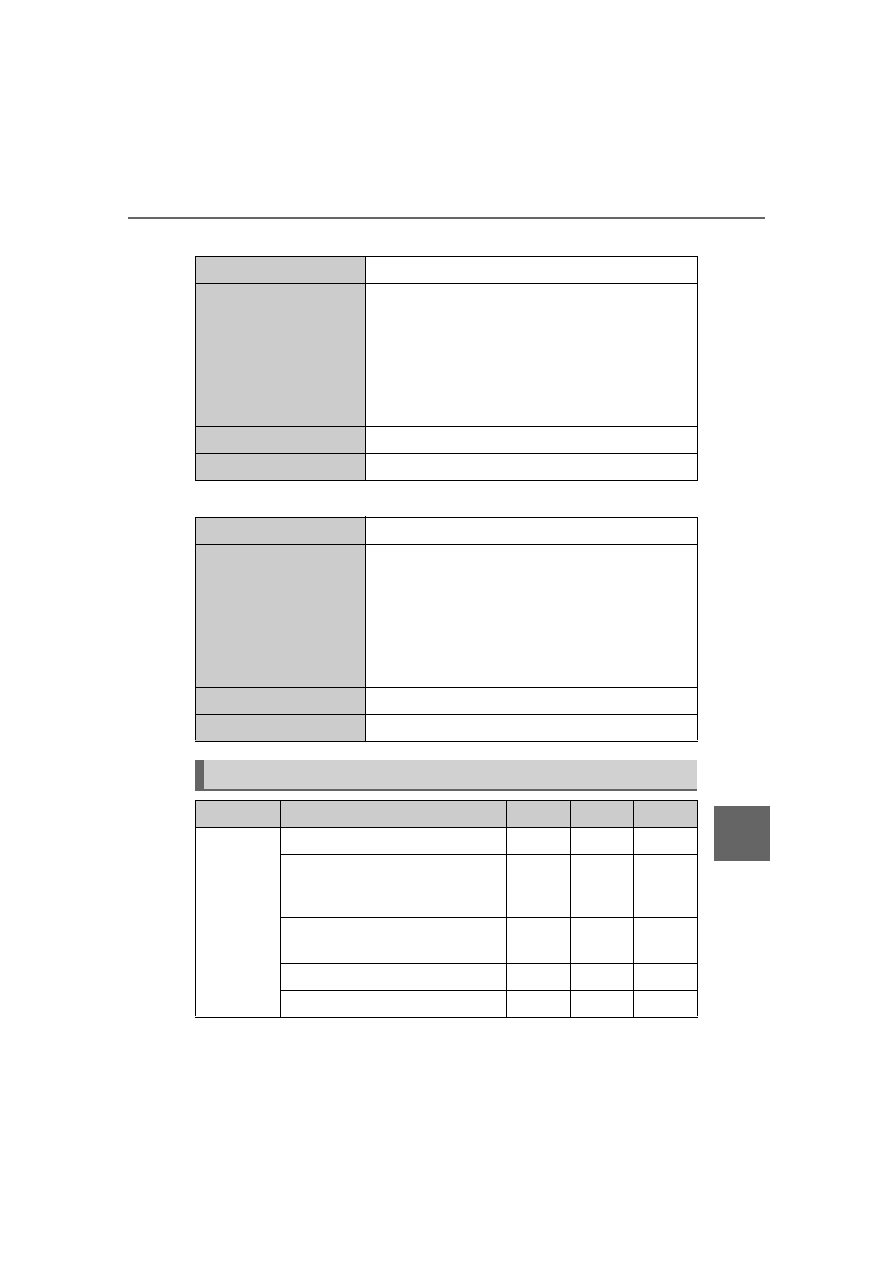
533
9-1. Specifications
9
Vehicle
specificatio
ns
Type E
Type F
Tire size
195/65R15 91S
Tire inflation pressure
(Recommended cold tire
inflation pressure)
Front
38 psi (260 kPa, 2.6 kgf/cm
2
or bar)
Rear
36 psi (250 kPa, 2.5 kgf/cm
2
or bar)
Spare
None
Wheel size
15 6 1/2J
Wheel nut torque
76 ft•lbf (103 N•m, 10.5 kgf•m)
Tire size
205/55R16 91H
Tire inflation pressure
(Recommended cold tire
inflation pressure)
Front
35 psi (240 kPa, 2.4 kgf/cm
2
or bar)
Rear
33 psi (230 kPa, 2.3 kgf/cm
2
or bar)
Spare
None
Wheel size
16 7J
Wheel nut torque
76 ft•lbf (103 N•m, 10.5 kgf•m)
Light bulbs
Light bulbs
Bulb No.
W
Type
Exterior
Front side marker lights
—
5
A
Front turn signal /parking lights
(vehicles without side turn signal
lights)
7444NA
28/8
B
Rear side marker lights (bulb
type)
—
5
A
Rear turn signal lights
—
21
B
Back-up lights
—
16
A
-------------------------------------------------------------------------------------------------------------------------------------------------------------

Нет комментариевНе стесняйтесь поделиться с нами вашим ценным мнением.
Текст